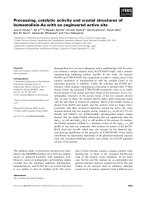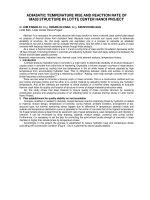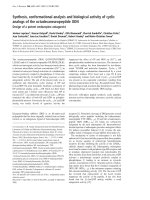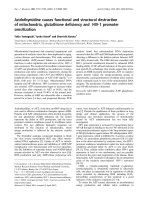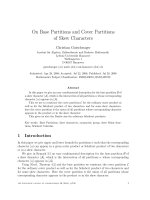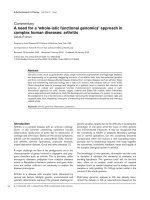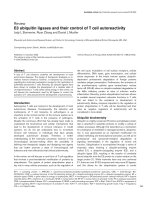Báo cáo y học: "On demand treatment and home therapy of hereditary angioedema in Germany - the Frankfurt experience" pptx
Bạn đang xem bản rút gọn của tài liệu. Xem và tải ngay bản đầy đủ của tài liệu tại đây (222.69 KB, 4 trang )
RESEA R C H Open Access
On demand treatment and home therapy of
hereditary angioedema in Germany - the
Frankfurt experience
Emel Aygören-Pürsün
*
, Inmaculada Martinez-Saguer, Eva Rusicke, Thomas Klingebiel, Wolfhart Kreuz
Abstract
Background: Manifestation of acute edema in hereditary angioedema (HAE) is characterized by interindividual and
intraindividual variability in symptom expression over time. Flexible therapy options are needed.
Methods: We describe and report on the outcomes of the highly individualized approach to HAE therapy
practiced at our HAE center in Frankfurt (Germany).
Results: The HAE center at the Frankfurt University Hospital currently treats 450 adults with HAE or AAE and 107
pediatric HAE patients with highly individualized therapeutic approaches. 73.9% of the adult patients treat HAE
attacks by on-demand therapy with pasteurized pd C1-INH concentrate, 9.8% use additional prophylaxis with
attenuated androgens, 1% of the total patient population in Frankfurt has been treated with Icatibant up to now.
In addition adult and selected pediatric patients with a high frequency of severe attacks are instructed to apply
individual replacement therapy (IRT) with pasteurized pd C1-INH concentrate. Improvement on Quality of Life items
was shown for these patients compared to previous long-term danazol prophylaxis. Home treatment of HAE
patients was developed in the Frankfurt HAE center in line with experiences in hemophilia therapy and has so far
been implemented over a period of 28 years. At present 248 (55%) of the adult patients and 26 (24%) of the
pediatric patients are practicing home treatment either as on demand or IRT treatment.
Conclusions: In conclusion, the individualized home therapies provided by our HAE center, aim to limit the
disruption to normal daily activities that occurs for many HAE patients. Furthermore, we seek to optimize the
economic burden of the disease while offering a maximum quality of life to our patients.
Introduction
On demand treatment of acute angioedema in HAE type I
and II
Hereditary angioedema (HAE) is based on a hereditary,
life-long deficiency of C1-esterase-inhibitor (C1-INH).
Patients wit h HAE suffer from recurrent, localiz ed,
acute edema attacks that can affect any body location.
Mainly affected are subcutaneous tissues or mucous
membranes, the gastrointestinal tract, and the throat,
the latter leading to potentially life-threat ening laryngeal
edema. Manifestation of acute edema in hereditary
angioedema is characterized by interindividual and
intraindividual variability in symptom expression over
time. The onset of the next attack, its location and its
severity are unpredictable. Treatment options adapted
on the specific needs of the individual patient need to
be implemented based on the type and frequency of
HAE attacks and should be re-evaluated from time to
time [1,2].
Worldwide, five different therapy options for on
demand therapy of acute attacks based on three distinct
pathophysiological approaches are currently under clini-
cal investigation or already approved in different coun-
tries. For replacement of lacking or dysfunctional
C1-INH, three different C1-INH concentrates - two
plasma-derived (pd) and one expressed in transgenic
rabbits - are available or under investigation. Antagon-
ism of the bradykinin B2-receptor, which is supposed to
largely convey the increase in vascular permeability lead-
ing to acute angioedema in HAE, via the B2-receptor
* Correspondence:
Centre of Pediatrics III, Department of Hematology, Oncology and
Hemostasis, Comprehensive Care Centre for Throm bosis and Hemostasis,
Johann Wolfgang Goethe University Hospital, Frankfurt am Main, Germany
Aygören-Pürsün et al. Allergy, Asthma & Clinical Immunology 2010, 6:21
/>ALLERGY, ASTHMA & CLINICAL
IMMUNOLOGY
© 2010 Aygören-Pürsün et al; licensee BioMed Central Ltd. This is an Open Access article distributed under the terms of the Creative
Commons Attribution License ( which permits unrestricted use, distribution, and
reproduction in any medium, provided the original work is properly cited.
antagonist Icatibant is an entirely different approach.
Additionally, inhibition of kallikrein, the activator of
high molecular weight kininogen (HMWK) and there-
fore promotor of bradykinin formation, is a further
potential therapeutic alternative.
In Germany, current treatment options a pproved for
therapy of acute angioedema in HAE-Type I and II
patients comprise intravenous replacement therapy with
a pasteurized pd C1-INH concentrate and subcutaneous
injection of the bradykinin B2-rece ptor antagonist Icati-
bant. Clinical efficacy has been d emonstrated in retro-
spective studies for pasteurized pd C1-INH concentrate
[3-5] and in prospective studies for both substances [6,7].
The clinical safety of pasteurized pd C1-NH concen-
trate has been proven over the last 25 years in more
than 500,000 administrations (data on file, CSL Behr-
ing), which were well tolerated. In this period of time,
only 8 allergic or anaphylactic reactions, including four
episodes in one HAE-Type I patient from Frankfurt,
have been observed. This corresponds to 1:50,000
administrations and thus to classification of allergic
reactionsasa“ very rare” (< 1:10,000) adverse event
according to the CIOMS III standard categories for clas-
sification of adverse drug reaction frequency [8]. No
proven cases of viral transmission from pasteurized pd
C1-INH concentrate have been shown in the last 25
years (data on file, CSL Behring) [9]. Pasteurized pd C1-
INH concentrate can be used in pediatric and adult
patients. It is well tolerated also in pregnant and breast-
feeding women [10].
Clinical experience with Icatibant is limited up to
now, as it has been only recently (2008) approved for
HAE in Germany. The safety of Icatibant has been
shown in clinical studies [11]. The most frequent side
effect, encountered in almost all treated subjects, is a
transient, itchy, and sometimes painful erythema at the
subcutaneous injection site. Common adverse reactions
of Icatibant are nausea, abdominal pain, asthenia,
increased blood creatinine phosphokinase, abnormal
liver function test, dizziness, headache, nasal congestion
and rash. Icatibant may be used up to 3 times within 24
hours. In the elderly patient (> 65 years) experience
with Icatibant is limited, as less than 5% of the study
population belongs to this age group [11]. Moreover,
clearance of Icatibant may decline with age, which may
lead to a higher exposure in elderly patients (> 75 yrs.).
Presently, no experience with administration of Icatibant
in pregnant or breastfeeding women or in children
exists. Caution should be observed in the administration
of Icatibant to patients with acute ischemic heart disease
or unstable angina pectoris and to patien ts in the weeks
following a stroke. According to the product’sprescrib-
ing information, no dose adjustment with hepatic or
renal impairment is required.
Differential therapy of C1-INH deficiency at the Frankfurt
HAE Center
Our HAE center at Frankfurt University Hospital cur-
rently treats 450 adults with heredita ry or acquired
(AAE) C1-INH deficiency (430 HAE and 20 AAE
patients), and 107 pediatric HAE patients with highly
individualized therapeutic approaches.
The majority (73.7%) of adult patients at the center
are candidates for sole on-demand therapy with pasteur-
ized pd C1-INH concentrate of acute HAE attacks.
However, 9.8% of adult patients qualify for long-term
prophylaxis with attenuated androgens (e.g., danazol),
although the latter, while being widely-used worldwide,
is not licensed for use in HAE [2]. Potential break-
through attacks in attenuated androgen-treated patients
are treated using pasteurized pd C1-INH concentrate on
demand.
In addition, we provide the option of individual repla-
cementtherapy(IRT)withpdC1-INHconcentratefor
high-risk patients [2]. HAE patients affected by a high
frequency of severe attacks (> 1 per week), and unre-
sponsive to long-term prophylaxis with attenuated
androgens were advised to administer pasteurized pd
C1-INH concentrate on early signs of an acute attack.
Patients usually administer a dose of 500 to 1000 U of
pasteurized pd C1-INH at each early sign of attack (i.e.
up to twice a week). This therapy protocol is being sup-
ported by the favorable pharmacokinetic properties of a
long half-life of pasteurized pd C1-INH concentrate in
different HAE patient subgroups (see Table 1) [12].
With IRT, a significant reduction of annual attack rates
compared to previous danazol prophylaxis was seen.
Particularly, laryngeal attacks were entirely abolished.
Moreover, a significant efficacy of IRT on all items of
quality of life (QoL) investigated was verified [2].
Ongoing long-term studies will furthermore evaluate the
efficacy and safety of IRT.
Home therapy with pd C1-INH concentrate in HAE
patients was developed in line with hemophilia therapy,
where the missing protein is administered by the patient
at home on an as-needed basis. Home treatment with
plasma derived and recombinant factor VIII and factor
IX concentrates is an established therapy in North
America since 1975 [13] and is included in the German
Guidelines on hemophilia therapy. In Frankfurt, home
therapy with p d C1-INH concentrate for use in o n
demand treatment or within the IRT protocol has been
implemented for a period of 28 years. At present, a total
of 274 patients (49% of all patients with C1-INH defi-
ciency treated by the center) are practicing home treat-
ment. Out of these, 248 are adult patients (55% of adult
patients) and 26 children (24% of pediatric patients).
The age of the relevant patient groups ranges between
18-81 years and 6-17 years, respectively. In young
Aygören-Pürsün et al. Allergy, Asthma & Clinical Immunology 2010, 6:21
/>Page 2 of 4
pediatric patients, parents are the care-givers for home
therapy. With pasteurized pd C1-INH home therapy, a
rapid response to treatment is observed. There were no
reports of treatment- related adverse events or life-
threatening events.
The experience with Icatibant in Frankfurt is very lim-
ited at the moment. 1% of the total patient population
at the Frankfurt HAE center has been treated with Icati-
bant within studies or in a routine setting. Due to its
pathophysiologic mechanism, which is different from
C1-INH, Icatibant is a valuable treat ment option in two
of our patients in whom pasteurized pd C1-INH con-
centrate cannot be applied: one patient with a known
allergy to pd C1-INH concentrate and one patient with
acquired angioedema non-responsive to pd C1-INH
conc entrate due to high anti-C1-INH antibody titers. In
the therapy of a life-long condition, pharmacoeconomic
considerations may also be of relevance. Based on the
current prices in Germany, the cost of on demand treat-
ment of an acute attack with one dose of Icatibant
(30 mg) is equal to the cost of one dose of 20 U/kg
body weight (bw) of pasteurized pd C1-INH concentrate
for a 70 kg standard patient. For a 100 kg patient receiv-
ing a dose of 20 U/kg bw therapy with pasteurized pd
C1-INH concentrate, is more expensive compared to
Icatibant.
However, in all other settings, e.g. in 50 kg-, 70 kg- or
100 kg - patients treated with a dos e of 10 U/kg pd C1-
INH concentrate, or even in a 50 kg- patient treated
with 20 U/kg pd C1-INH concentrate, treatment with a
single dose of Icatibant is more expensive compared to
pd C1-INH concentrate. This is important in view of
the fact that in contrast to the results of the IMPACT-1
study [6] the necessity for a dose of 20 U/kg of pd C1-
INH concentrate is ra re in clinical practice. In the vast
majority of cases, 500 - 1000 U pasteurized pd C1-INH
concentrate, usually corresponding to ≤ 10 U/kg to < 20
U/kg, are effective for treatment of acute attacks, parti-
cularly when treatment is initiated rapidly [3-6].
Furthermore, follow-up doses of pd C1-INH concentrate
can be administered in fractions of 500 U, which is sig-
nificantly more economical compared to follow-up
injections of Icatibant that may be commonly required
[11].
In conclusion, the individualized therapeutic strate gies
provided by our HAE center aim to limit the constraints
in daily life that occur for many HAE patients.
Furthermore, we seek to optimize the economic bur-
den of the disease while offering a maximum quality of
life to our patients.
List of Abbreviations
AAE: acquired angioedema; bw: body weight; C1-INH: C1-esterase-inhibitor;
HAE: hereditary angioedema; IRT: individual replacement therapy; pd: plasma
derived
Acknowledgements
We are grateful for the excellent support provided by the nursing staff at
our clinical unit, especially Karin Andritschke und Birgit Luft, and by our
technicians Hildegard Stoll, Ruth Biller, and Sylvia Figura, who analyzed
plasma C1-INH levels and other laboratory parameters. In addition, our
efforts benefited from the continuous support received over the years from
our assistants Sigrun Preisser and Katharina Brassat.
Financial support: CSL Behring GmbH, Hattersheim, Germany
Authors’ contributions
All authors contributed equally to this manuscript and have read and
approved the final version of this manuscript.
Competing interests
This study was supported by an unrestricted grant from CSL Behring GmbH,
Hattersheim, Germany. CSL Behring GmbH had no influence on the
collection, analysis, or interpretation of data, and had no influence on the
decision to submit this manuscript for publication.
The authors certify that they have no affiliation with or financial involvement
in any organization or entity with direct financial interest in the subject
matter or materials discussed in this manuscript (e.g., employment,
consultancies, board membership, stock ownership). Any research or project
support is identified in the manuscript. The corresponding author receives
support for participation of scientific conferences from CSL Behring, Shire
and Viropharma.
Received: 2 June 2010 Accepted: 28 July 2010 Published: 28 July 2010
References
1. Bowen T, Cicardi M, Bork K, Zuraw B, Frank M, Ritchie B, Farkas H, Varga L,
Zingale LC, Binkley K, Wagner E, Adomaitis P, Brosz K, Burnham J,
Warrington R, Kalicinsky C, Mace S, McCusker C, Schellenberg R, Celeste L,
Hebert J, Valentine K, Poon MC, Serushago B, Neurath D, Yang W,
Table 1 Pharmacokinetics of pasteurized pd C1-INH Concentrate (median values)
Incremental IVR
[%rise/U/kg bw]
Tmax
[hr]
T 1/2
[hr]
MRT
[hr]
AUC
[U*hr/mL]
Clearance
[mL/kg*hr]
Vss
[mL/kg]
Children on Demand n = 6 2.2 0.6 32.9 47.5 13.4 1.1 50.0
Adults on Demand n = 19 2.0 1.0 39.1 56.5 16.7 0.9 56.5
Adults IRT n = 15 2.9* 0.5 30.9** 44.6** 15.7 1.0 37.5***
*p = 0.006, ** p = 0.052, *** p = 0.004, statistically significant differences of Adults IRT vs. Adults on demand
IVR = in vivo recovery
Tmax = Median time to max imum functional pd C1-INH level
T1/2 = Terminal elimination half-life
MRT = Mean residence time
AUC = area under the curve
Vss = Volume of distribution at steady state
Aygören-Pürsün et al. Allergy, Asthma & Clinical Immunology 2010, 6:21
/>Page 3 of 4
Lacuesta G, Issekutz A, Hamed A, Kamra P, Dean J, Kanani A, Stark D,
Rivard GE, Leith E, Tsai E, Waserman S, Keith PK, Page D, Marchesin S,
Longhurst HJ, Kreuz W, Rusicke E, Martinez-Saguer I, Aygören-Pürsün E,
Harmat G, Füst G, Li H, Bouillet L, Caballero T, Moldovan D, Späth PJ, Smith-
Foltz S, Nagy I, Nielsen EW, Bucher C, Nordenfelt P, Xiang ZY: Hereditary
angiodema: a current state-of-the-art review, VII: Canadian Hungarian
2007 International Consensus Algorithm for the Diagnosis, Therapy, and
Managment of Hereditary Angioedema. Ann Allergy Asthma Immunol
2008, 100:S30-40.
2. Kreuz W, Martinez-Saguer I, Aygören-Pürsün E, Rusicke E, Heller C,
Klingebiel T: C1-inhibitor concentrate for individual replacement therapy
in patients with severe hereditary angioedema refractory to danazol
prophylaxis. Transfusion 2009, 49:1987-1995.
3. Bork K, Barnstedt SE: Treatment of 193 episodes of laryngeal Edema With
C1 Inhibitor Concentrate in patients With Hereditary Angioedema. Arch
Intern Med 2001, 161:714-718.
4. Bork K, Meng G, Staubach P, Hardt J: Treatment with C1 Inhibitor
Concentrate in Abdominal Pain Attacks of Patients with Hereditary
Angioedema. Transfusion 2005, 45:1774-1784.
5. Bork K, Staubach P, Hardt J: Treatment of Skin Swellings with C1-Inhibitor
Concentrate in patients with Hereditary Angio-oedema. Allergy 2008,
63:751-757.
6. Craig TJ, Levy RJ, Wasserman RL, Bewtra AK, Hurewitz D, Obtulowicz K,
Reshef A, Ritchie B, Moldovan D, Shirov T, Grivcheva-Panovska V,
Kiessling PC, Keinecke H-O, Bernstein JA: Efficacy of Human C1 esterase
Inhibitor concentrate compared with Placebo in Acute Hereditary
Angioedema Attacks. J Allergy Clin Immunol 2009, 124:801-808.
7. Cicardi M, Zingale L, Zanichelli A, Lambertenghi Deliliers D: Established and
new Treatments for Hereditary Angioedema: An Update. Molecular
Immunology 2007, 44:3858-3861.
8. CIOMS III: Guidelines for Preparing Core Clinical Safety Information on
Drugs., Assessed online as: 20090519100059324.pdf.
9. Bork K: Pasteurized C1 Inhibitor Concentrate in Hereditary Angioedema:
Pharmacology, Safety, Efficacy and Future Directions. Expert Rev Clin
Immunol 2008, 4:13-20.
10. Martinez-Saguer I, Rusicke E, Aygören-Pürsun E, Heller C, Klingebiel T,
Kreuz W: Characterization of Acute Hereditary Angioedema Attacks
During Pregnancy and Breast-feeding and Their Treatment with C1
Inhibitor Concentrate. Am J Gyn Obstet 2010.
11. Deeks ED: Icatibant. Drugs 2010, 70:73-81.
12. Martinez-Saguer I, Rusicke E, Aygören-Pürsün E, von Hentig N, Klingebiel T,
Kreuz W: Pharmacokinetic Analysis of Human Plasma-derived Pasteurized
C1-inhibitor Concentrate in Adults and Children with Hereditary
Angioedema: a Prospective Study. Transfusion 2010, 50:354-360.
13. Teitel JM, Barnard D, Israels S, Lillicrap D, Poon MC, Sek J: Home
Management of Haemophilia. Haemophilia 2004, 10:118-133.
doi:10.1186/1710-1492-6-21
Cite this article as: Aygören-Pürsün et al.: On demand treatment and
home therapy of hereditary angioedema in Germany - the Frankfurt
experience. Allergy, Asthma & Clinical Immunology 2010 6:21.
Submit your next manuscript to BioMed Central
and take full advantage of:
• Convenient online submission
• Thorough peer review
• No space constraints or color figure charges
• Immediate publication on acceptance
• Inclusion in PubMed, CAS, Scopus and Google Scholar
• Research which is freely available for redistribution
Submit your manuscript at
www.biomedcentral.com/submit
Aygören-Pürsün et al. Allergy, Asthma & Clinical Immunology 2010, 6:21
/>Page 4 of 4
